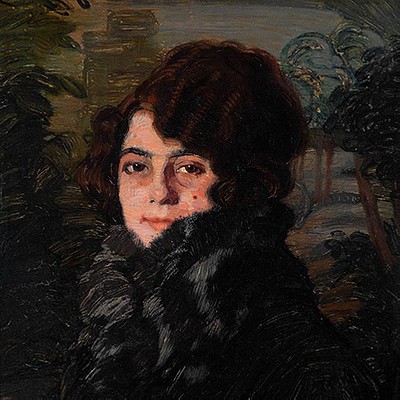JOAQUIN MIR TRINXET (Barcelona, 1873 - 1940). "Street with figures". Oil on canvas.
Lot 41
About Seller
Setdart Auction House
Carrer Aragó 346
Barcelona
Spain
Setdart Subastas was born in 2004 and is currently the first online art auction in Spain with solidity, prestige and reliability guaranteed by our more than 60,000 users. Setdart has a young, dynamic and enterprising team ready to successfully manage the purchase and sale of art works through custom...Read more
Estimate:
EUR€7,000 - EUR€8,000
$7,291.67 - $8,333.33
Absentee vs Live bid
Two ways to bid:
- Leave a max absentee bid and the platform will bid on your behalf up to your maximum bid during the live auction.
- Bid live during the auction and your bids will be submitted real-time to the auctioneer.
Bid Increments
| Price | Bid Increment |
|---|---|
| EUR€0 | EUR€10 |
| EUR€200 | EUR€25 |
| EUR€500 | EUR€50 |
| EUR€1,000 | EUR€100 |
| EUR€3,000 | EUR€200 |
| EUR€5,000 | EUR€500 |
| EUR€10,000 | EUR€1,000 |
| EUR€20,000 | EUR€2,000 |
| EUR€50,000 | EUR€5,000 |
About Auction
By Setdart Auction House
Jul 15, 2021
Set Reminder
2021-07-15 08:00:00
2021-07-15 08:00:00
America/New_York
Bidsquare
Bidsquare : 19th & 20th CENTURY PAINTINGS & ORIENTALISM
https://www.bidsquare.com/auctions/setdart-auction-house/19th-20th-century-paintings-orientalism-7212
Setdart Auction House sofia@setdart.com
Setdart Auction House sofia@setdart.com
- Lot Description
JOAQUIN MIR TRINXET (Barcelona, 1873 - 1940). "Street with figures". Oil on canvas. Signed in the lower right corner. Size: 38 x 50 cm; 54 x 62 cm (frame). Joaquim Mir presents us with a masterful urban landscape determined by the trustworthy character in its representation. Thus, we observe a composition structured around a central road that divides the work into two parts, full of pedestrians who, in their comings and goings, animate the composition. Mir performs a magnificent plastic exercise, recreating himself in the textures and in the vibration of the masses of color, reflected by a long, loose, dense and enormously expressive brushstroke, the absolute protagonist of the work. Joaquim Mir studied at the School of Fine Arts of San Jordi in Barcelona and in the workshop of the painter Luis Graner. His style was also influenced by the School of Olot, his father's hometown. He soon felt uncomfortable with the official teaching, anchored in a conception of realist painting, so in 1893 he founded together with other colleagues (Nonell, Canals, Pichot, Vallmitjana and Gual) the "Colla del Safrà", to investigate together in the pictorial initiatives of the end of the century. In 1896 they came to participate as a group in the III Exhibition of Fine Arts and Artistic Industries, to which Mir presented two works that give us a clear idea of the ideals of the group: "La huerta del rector" and "El vendedor de naranjas". Also, since 1897 he frequented the artistic environment of "Els Quatre Gats", where all the artists who knew the European avant-garde met, which helped him to mature in the compositional study of landscapes with figures in different planes of depth. From this period are "Slopes of Montjuic" (1897) and "The Cathedral of the Poor" (1898), the two masterpieces of his youth. In these years he took part in the Fine Arts Exhibitions of Barcelona, in their editions of 1894, 1896 and 1898. Winner of a second medal at the Madrid Exhibition of 1899, that same year he moved to the capital in order to compete for a scholarship in Rome. When he was unsuccessful, he went with Santiago Rusiñol to Mallorca, on a trip that would be a definitive turning point in his career. Mir was dazzled by the Mallorcan landscape, specifically by the landscape of Sa Calobra, which was an inexhaustible source of inspiration for him. From then on, the artist deployed a whole combination of impossible colors, the result of his personal interpretation of the majestic nature of the island. The brushstrokes became longer and became stains that almost made objects and spatial references disappear. In 1901 he exhibited the fruit of this first Mallorcan stage individually at the Sala Parés in Barcelona, and again obtained a second medal at the National Exhibition. After a period of illness that forced him to move to Reus, in 1907 he won the first medal at the International Exhibition of Fine Arts in Barcelona. From then on, settled in Camp de Tarragona, he would not move from the landscape genre, but now the surrounding villages would be the protagonists of his painting. Already consolidated as an outstanding figure of the Catalan panorama, he acquires the definitive national recognition in 1917, when he is awarded the National Prize of Fine Arts. Four years later he married and settled permanently in Vilanova i la Geltrú. His successes followed one after the other, and in 1929 he won the first medal at the International Exhibition in Barcelona. The following year he won the medal of honor at the National Exhibition in Madrid, an award he had been pursuing since 1922. Although he was mainly a native painter, he had solo and group exhibitions in Washington, Paris, Pittsburg, New York, Philadelphia, Amsterdam, Buenos Aires and Venice. Mir is today considered the most outstanding representative of Spanish post-impressionist landscape painting. His work is preserved in the National Art Museum of Catalonia, the Prado Museum, the Thyssen-Bornemisza Museum and the Reina Sofia Museum in Madrid, among many others.
- Shipping Info
-
In-house shipping available. Please inquire at admin@setdart.com.
-
- Buyer's Premium



 EUR
EUR CAD
CAD AUD
AUD GBP
GBP MXN
MXN HKD
HKD CNY
CNY MYR
MYR SEK
SEK SGD
SGD CHF
CHF THB
THB













